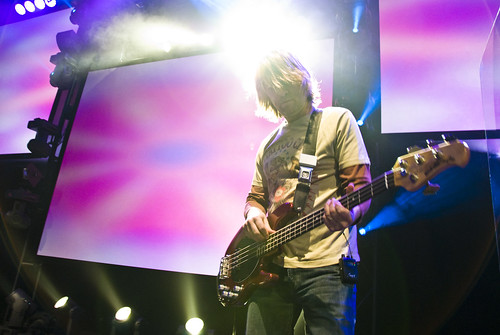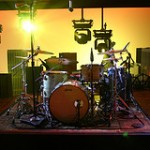When You Want More Than Just Feeling It…
There were requests a while back to talk about bass guitar in the same fashion I’ve talked about vocals and drums. This isn’t really that post because I need to tap Briley for that one as he’s still my biggest mentor when it comes to mixing bass. But in the meantime, I tried something new last week that I kind of liked and is pretty easy to try if you’re looking for something new to play with.
These tips come courtesy of Jayce Fincher who is the Tech Director for the Attic at North Point. The Attic is where our high school and middle school kids get together and make a bunch of noise. Before Jayce ended up at North Point he used to play bass in a little band called Marvelous 3, and a couple weeks ago I walked into a conversation between Jayce and one of our FOH volunteers on mixing bass guitar. Jayce was talking about the challenge of getting the note of the instrument to cut which is something I struggle with. Jayce had a couple of pretty basic tips for helping to get the bass note to sit right without the whole instrument turning into a washy mess of low end.
Start by leaving the bass guitar out of the subs when you initially put it in the mix. This is most easily accomplished if your subs are aux-fed. If your subs aren’t on an aux, you can achieve almost the same effect by either turning off your subs or utilizing a high pass filter or a low shelf on the EQ. However you do it, the goal is to get all of that head-y low end stuff around 100 Hz and the rest of the sub-bass pulled out. Once you’ve got all of that out, it is a lot easier to find the note and get it defined. Start by cleaning up any remaining mud down low, and then go looking for the note if it’s still missing. Jayce recommended starting to boost around 500 Hz, but I think you could find what you’re looking for going up to 700 and even as high as 1k; I think it’s going to depend a lot on the instrument and player and what’s happening with the rest of your mix. Once you have the bass guitar sitting in your mix nice, start dialing it back into your subs until you get the right feel you like back without overwhelming the rest of the mix.
When I played with this last weekend, I definitely liked it, but I still found myself using a little of the “dirty” bass trick that Briley and a guy named Scovill like. Basically I take the bass guitar and double patch it on the Venue into two channels. One channel is the “clean” channel which I stick a compressor on and EQ in a traditional fashion. The second channel is the “dirty” channel which additionally gets a SansAmp plugin; the SansAmp gives it some grit and nice harmonics which help it cut a bit. I’ll then blend the two to taste with the dirty channel giving me more “note” and the clean channel giving me more “I’m not happy if I can’t feel it” low end.
I would love to hear any other tricks some of you guys have on getting the note of the bass to cut without overwhelming your mix with low end. The comments are open.


 Previous Post
Previous Post



This is the way I mix bass at our church in Baton Rouge. I start out with a flat EQ on the strip and roll HPass filter up to around 125. Then I boost low mid about 6 to 8db and start aroud 500h up to 700 until I find the sweet spot, then the same with HMid at 1k. I also add some HFreq. I then start rolling down the HPass till it gets muddy then back uo a few clicks. I then add compression. I have found that most bass players are different in the way they “strike” the strings so you do have to take a litte time with different players.
I have known Jayce for about 25 yrs. I was their FOH / Tour Manager for the first SouthGang tour.
“If you get the booty right, everything else falls into place.”
As a bass player and sound guy I love to have the dirty channel patched but instead of the FOH guy getting all the say in the “tone” we work through it with my pedals. I like pedals, I know I am a bass player not a guitar player but we should still get to have some fun. Anyway, I haven’t got to run things this way because no one wants to run two bass channels and let me play with effects pedals during songs. So, that’s my .02. . . . . .
Great post here. I really struggle with washy/muddy bass guitar, and I battle to bring out it’s presence in the mid/upper range. This post provides 2 great tips. The initial tip to keep the subs off and find the note. And of course, the dual Bass channel approach. It’s really odd that I hadn’t actually tried that yet, since I have done it with various other instruments, and it’s a staple technique for me in the studio. Anyhow, I combined these two techniques at service tonight and really felt a significant improvement in my bass sound.
Side note: I don’t have sans amp, so I used Eleven for my dirty bass. I liked the DC Vintage Amp with the 4×12 Classic 30. I used to use Tapehead on my bass, and I really liked it, but since I am blending two bass signals, tapehead doesn’t get quite aggressive enough.
A little late on this discussion…
I just recently quit my “mega-church” job to have a more “family friendly” career in A/V, so I won’t get to use this as often.
The technique you laid out is pretty much exactly where I start…with a few added elements.
After EQing, I pan Kick hard left and Bass Hard right then visually set the levels equally. Most of my experience came out of the studio, but works well in a Live environment also. When done setting the levels…I pan back toward center, but not straight up 12o’clock. Instead, I put Kick about about 3 or 4 Left of center and Bass at 3 or 4 right of center. This is very helpful in cleaning up the “muddiness.”
There have been times where I don’t put the Bass in subs at all. If your musicians are tight and play a lot together, you bass player will be right with the Kick and you feel like the bass is in there. This will help you get more out of the kick as well.
When building my mix, which I do every weekend I mix, I always start with Kick & Bass, then Overheads, then Snare…then rhythm instruments, then lead instruments. Typically, electric guitar is the last thing I bring in…aside from vocals of course.
I’m particularly found of my technique and of all the various comments over my years mixing in the studio and live, I’ve always got positive response on my bass sound.
I have 2 bass channels as well. And being a bass player as well. I do get quite picky about my wall of thundering low frequencies. One is the cabinet mic’d up with a SM57 going to an SSL preamp. So the cabinet sounds slightly dirty even though the preamp is ridiculously clean. The second channel is DI going to an API preamp (very colored slightly dirty sound). On the API channel I cut everything above 120Hz so it’s only low frequencies. On the cabinet channel I High Pass 120Hz and end up boosting 400Hz narrow Q and 700-11kHz through the roof with a medium Q.